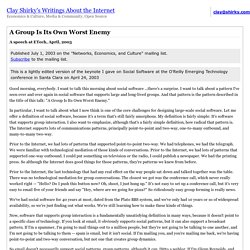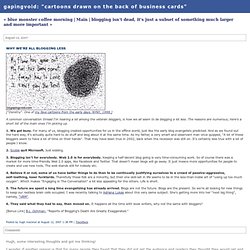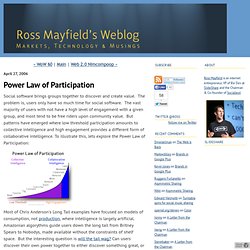

A Group Is Its Own Worst Enemy. A Group Is Its Own Worst Enemy A speech at ETech, April, 2003 Published July 1, 2003 on the "Networks, Economics, and Culture" mailing list.

Subscribe to the mailing list. This is a lightly edited version of the keynote I gave on Social Software at the O'Reilly Emerging Technology conference in Santa Clara on April 24, 2003 Good morning, everybody. In particular, I want to talk about what I now think is one of the core challenges for designing large-scale social software. Prior to the Internet, we had lots of patterns that supported point-to-point two-way.
Prior to the Internet, the last technology that had any real effect on the way people sat down and talked together was the table. We've had social software for 40 years at most, dated from the Plato BBS system, and we've only had 10 years or so of widespread availability, so we're just finding out what works. So email doesn't necessarily support social patterns, group patterns, although it can. This talk is in three parts. Business Networking. Social Media Classroom. TWITTER TOOLBOX: 60+ Twitter Tools. Twitter is a great service, but it would be nothing without the other sites, tools, and apps that help you get the most out of it.

Here we highlight more than 60 of our favorite Twitter add-ons. See also: 8 Awesome Firefox Plugins for Twitter Apps, Widgets and Plugins - Windows Triqqr - Submit tweets directly to Twitter and view user profiles. Pwytter - Cross platform Python Twitter client with Asian character support. Teletwitter - Experimental open source client. TwitBox - View and submit tweets, see replies and direct messages, delete your own tweets, and multiple account support. Twitterlicious - Update Twitter status, easily check replies and direct messages. Twitteroo - Client with rurl URL shortening, clickable links and tweets, customization, and both public and friend timelines. Chirrup - Twitter client with extensive Japanese language support. TwittIt - Extremely compact and simple app for submitting tweets. Cartoons drawn on the back of business cards": why we're all blogging less.
Why we're all blogging less ["Dorothy".

One of my fave cartoons from the early days. NYNY, 1998.] A common conversation thread I'm hearing a lot among the veteran bloggers, is how we all seem to be blogging a lot less. The reasons are numerous; here's a short list of the main ones I'm picking up. 1. 2. 3. 4. 5. 6. [Bonus Link] B.L .Ochman: "Reports of Blogging's Death Are Greatly Exaggerated. " Posted by hugh macleod at August 12, 2007 1:38 PM | TrackBack.
Ross Mayfield's Weblog: Power Law of Participation. Social software brings groups together to discover and create value.

The problem is, users only have so much time for social software. The vast majority of users with not have a high level of engagement with a given group, and most tend to be free riders upon community value. But patterns have emerged where low threshold participation amounts to collective intelligence and high engagement provides a different form of collaborative intelligence. To illustrate this, lets explore the Power Law of Participation: Most of Chris Anderson's Long Tail examples have focused on models of consumption, not production, where intelligence is largely artificial. As we engage with the web, we leave behind breadcrumbs of attention. Digg is the archetype for low threshold participation.
The byproduct of use is a Conucopia of the Commons -- the act of using the database adds value to it. In Wikipedia, 500 people, or 0.5% of users, account for 50% of the edits.